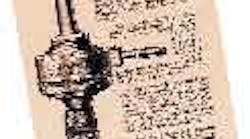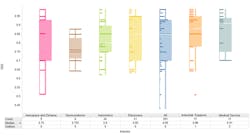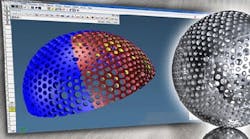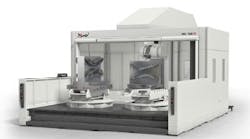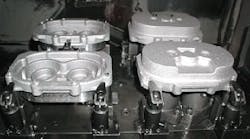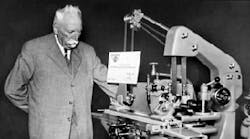AMERICAN MACHINIST chronicles 25 member companies that not only changed the metalworking field but have also stood the test of time.
1833 — The firm of David Brown & made and repaired clocks and watches. Twenty years later, the company's apprentice, Lucian Sharpe, made a full partner of the renamed R. Brown & Sharpe.
1859 — Giddings & Lewis was founded. By 1880, the company, then known as DeGroat, Giddings & Lewis, manufactured sawmill machinery and steam engines. The firm did complete installations wherever it did business. However, the first such complete job nearly bankrupted the company when the customer defaulted.
1860 — Moore Measurement Solutions/Pratt & Whitney began manufacturing guns and gunmaking machinery for the Civil War. The firm used the concept of interchangeable parts pioneered by Samuel Colt, Elijah Root, and Amos Whitney's cousin Eli (the inventor of the cotton gin).
1861 — Charmilles Technologies, which would become a leader in EDM technology, started as Staib & Cie. In 1921, the company adopted the name Ateliers des Charmilles.
1862 — American SIP's roots go back to Switzerland. One of its customers was Thomas Edison.
1865 — The Gleason Co., which started out making engine lathes, planers, and woodworking machinery, launched what could be considered one of the earliest attempts to establish an overseas market by a U.S. company. William Gleason, company founder, had a daughter who was the firm's chief salesperson, and she traveled alone to Europe by cattle steamer to secure orders from major firms in England, Scotland, France, and Germany.
1875 — Taft-Peirce Mfg. Co. was started. Today, the company is called Suburban Tool.
1876 — Crucible Materials Corp., with roots dating back to 1776 in England, began producing fine tool steels for saw blades, files, swords, plows, and more in Syracuse, N.Y. These steels were made by the crucible method. During the process, 3,000° liquid steel was poured or "teemed" into molds. The pourer (or teemer as they were called) wrapped his legs in wool and burlap thoroughly soaked with cold water as protection from the intense heat. An image of a teemer has been used as the company's logo for many years.
1877 — The first issue of AMERICAN MACHINIST MAGAZINE was published, started by Jackson Bailey and Horace Miller. The firm of Miller & Bailey printed 5,000 copies of this issue, which it said it would distribute "gratuitously." Subscriptions started at $1.50 per year.
1880 — Lewis Young's invention, the axle cutter for horse-drawn wagons, spurred the start of the Butterfield Co., which today, is known as Tivoly Inc.
1884 — The state of Ohio approved the articles of incorporation for The Cincinnati Screw and Tap Co., now Cincinnati Machine. Cincinnati Screw and Tap made sewing machine parts for repair work and special machines such as screw machines.
1885 — Detroit Edge Tool Works supplied industrial knives to the lumber and woodworking industries, and eventually made shear blades for the metalworking industry.
1887 — John H. Osborn started Osborn Manufacturing Co. At one time, the company shared its building with a steam laundry, noodle factory, and a candy factory.
1887 — R. K. LeBlond Machine Tool Co. was founded, eventually becoming Makino.
1886 — Thomas and William Taylor found what is now Taylor Hobson Precision.
1887 — L.S. Starrett made his first combination squares.
1889 — Carpenter Steel Co., now Carpenter Technology Corp., opened for business. At the time, it was the world's largest producer of armor piercing projectiles.
1889 — Brothers F.F. and A.B. Landis struggled for several years before starting their Landis Bros. machine tool company. Although their machines were well designed, manufacturers at the time were reluctant to accept grinding as a finishing process.
1889 — Dr. Johannes Heidenhain started what is now Heidenhain Corp. It began as a metal-etching company.
1889 — Pannier Corp., in its founding years, delivered product — rubber stamps, brass stencils, and steel stamps — in a children's-type wagon.
1890 — Franklin and Henry Hardinge began producing lathes in Chicago for watchmakers. The company was originally Hardinge Brothers Inc., and now its Hardinge Inc.
1891 — John Oliver and George Bardons made turret lathes in Cleveland under the name of Bardons & Oliver.
1892 — Stäubli Unimation, which started as a mechanical workshop in Switzerland, has evolved into a manufacturer of 5 and 6-axis robot systems.
1894 — Harry Thayer Kingsbury purchased the financially strapped Wilkins Toy Co. What started with toys, developed into the Kingsbury Machine Tool Co. with Edward Kingsbury, Harry's eldest son, at the helm.
1898 — Eiichi Okuma opens his Okuma Noodle Machine Manufacturing Co. Military demands then force Eiichi to go from noodles to machine tools, and the company becomes Okuma Machinery Works Ltd.
